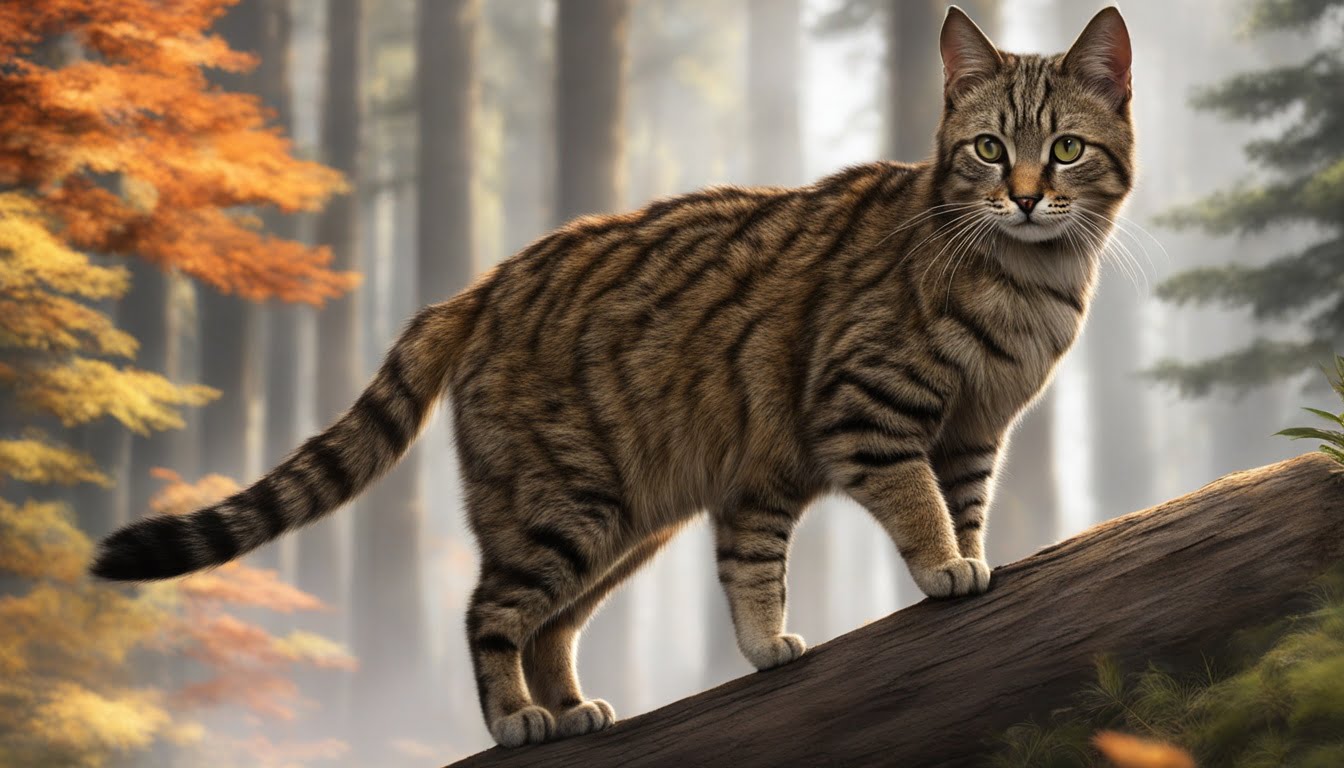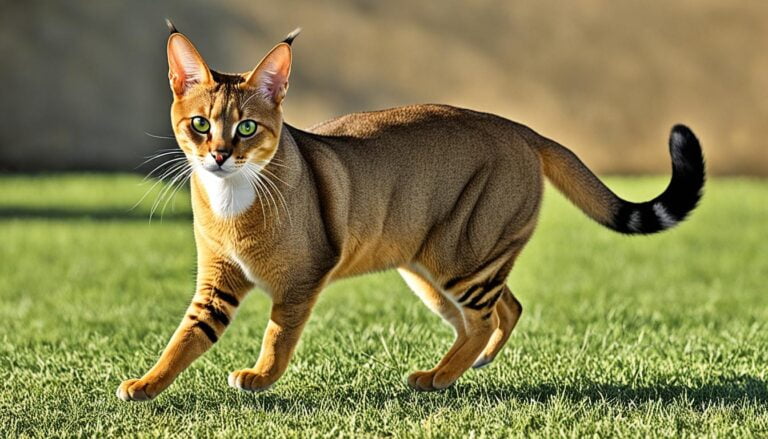The Pixiebob: Is This Wild-Looking Cat Part Bobcat?
Many think the Pixiebob looks like a bobcat. So, they wonder if it’s a mix of a house cat and a wild one. But is this big cat really part bobcat, or is it something else? Let’s explore the Pixiebob’s history and genes to find out.
A Ferociously Fabulous Look
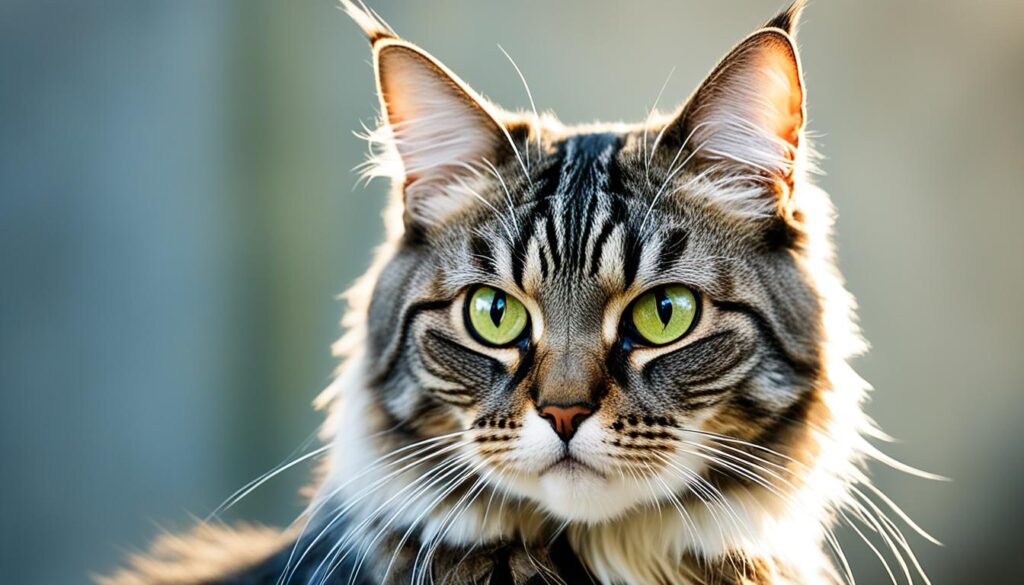
The pixie bob is a big, strong cat with a wild look. It was made in 1985 by a woman in Washington State. People wanted a big, ferocious-looking kitty to own.
These domestic cats resembling wild cats have a thick coat that can be long or short. They have a special brown, spotted pattern.
One cool thing about pixiebob cats is their black-tipped ears and black feet pads. They might even have up to seven toes on each paw. This makes them look unique.
Their tail is short, which is a key feature. It’s usually just a few inches long.
The pixie bob is a cat that catches the eye. They are strong, have cool markings, and look a bit wild. These cats mix domestic and wild looks in a special way.
Not So Wild After All
People thought the pixiebob was part bobcat, but DNA tests say otherwise. These cats look wild but are really just domestic cats. The pixiebob is now a recognized domestic breed by the International Cat Association (TICA). This means you can have one as a pet without any legal issues.
The story of the pixiebob started in 1985 with a mix of a domestic cat and a North American bobcat. But DNA tests from the Veterinary Genetics Laboratory at UC Davis showed otherwise. They found the pixiebob is a pure domestic cat, with no bobcat DNA.
TICA first let the pixiebob be shown in 1993. Then, it got “New Breed and Color” status in 1996 and full Championship status in 1998. This makes the pixiebob a true domestic breed, not a wild mix.
The Pixiebob: Is This Wild-Looking Cat Actually Part Bobcat?

The pixiebob is a special kind of cat that looks very wild. But, they don’t have any bobcat ancestry, even though their breeder said they did. Tests showed they are all domestic cats, not part bobcat.
Pixiebobs look exotic but are really a domestic breed. The International Cat Association says so. They weigh 8 to 17 pounds and are 9 to 13 inches tall. They look wild but are really friendly and calm.
The pixiebob looks a bit like a bobcat but isn’t one. They are all domestic cats. People love them for their cool looks and friendly nature.
A Personal Name

The origin of the Pixiebob name is a cool story. It comes from the first Pixiebob cat, named Pixie. This cat was special and started the Pixiebob breed. Now, all Pixiebobs are named after her to keep her memory alive.
Carol Ann Brewer found Pixie in the early 1980s. This led to a special breeding program. Pixie looked like a bobcat and was friendly. She became the base for the Pixiebob breed. The Pixiebob shows how one special cat can change everything.
A Dog-Like Cat
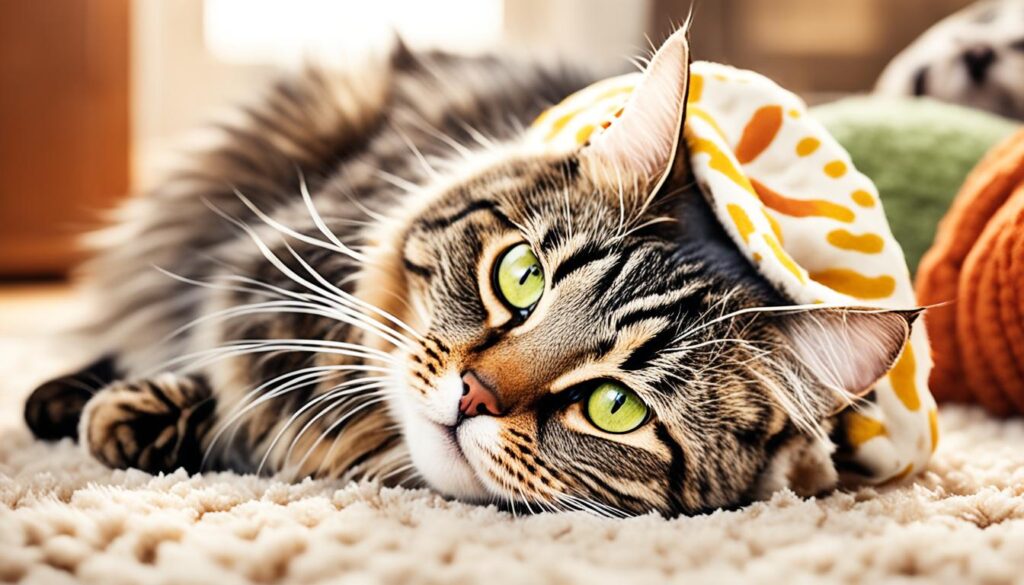
Surprisingly, the pixiebob is a cat that acts a lot like a dog. These wild-looking cats love to go for walks with their owners. They also do well with training.
They even like to join you in the shower because they love water. Their pixiebob personality and pixiebob behavior make them great friends. They follow their owners around the house like a loyal dog.
The pixiebob is a special cat mix that has traits of both cats and dogs. They are medium-sized, weighing 8 to 17 pounds and being 20 to 24 inches long. This makes them a great size for being pixiebobs as pets.
They live about 13 to 15 years, giving you a long time to enjoy them. Keeping their coat clean is important because they shed a bit. But, it’s worth it for their pixiebob personality and pixiebob behavior.
The Quiet Kitty
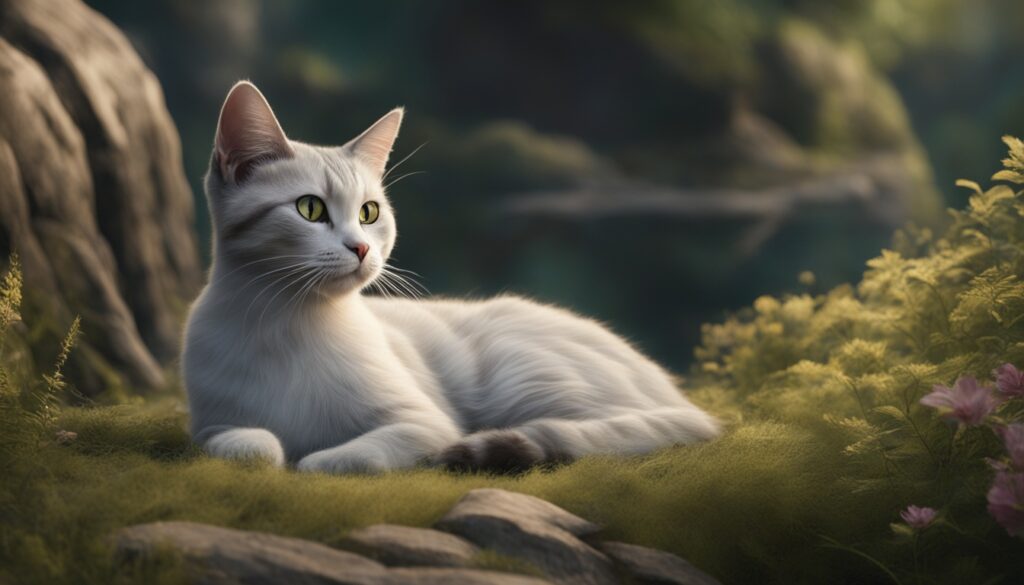
Even though they look fierce, pixiebobs are really quiet cats. They don’t meow like many other cats do. Instead, they make soft chirps and trills. This makes them perfect for people who want a quiet cats friend.
Pixiebobs look like mini bobcats but they don’t sound scary. They don’t meow much. They make soft sounds that are easy to talk to. This is great for those who like a calm home, as pixiebobs don’t make a lot of noise.
Pixiebobs are not only quiet but also very friendly and playful. They look wild but love being with people. Their pixiebob sound is soft and they don’t talk much. This makes them a great choice for anyone looking for a quiet, loving pet.
Breed Standards
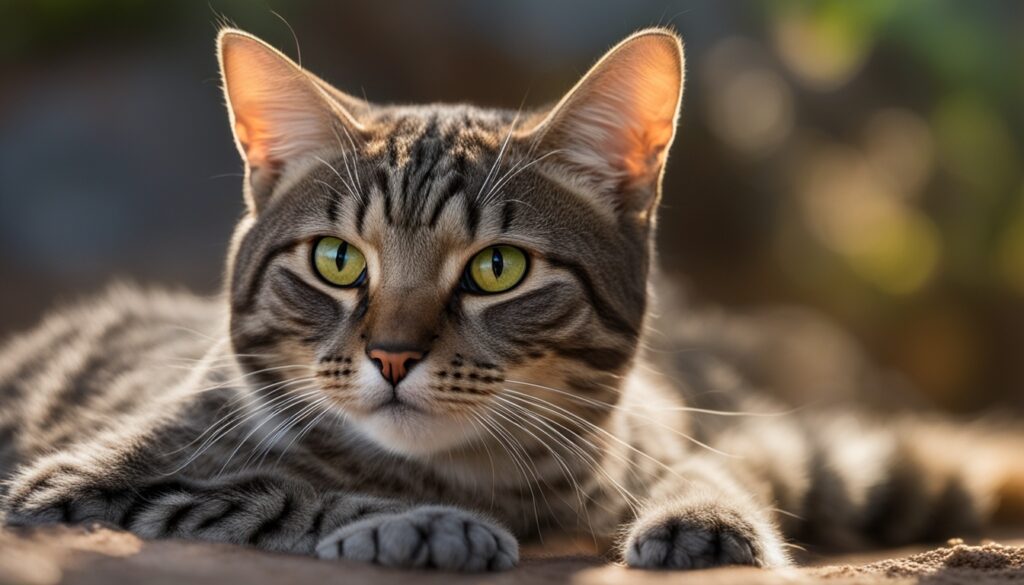
The Pixiebob breed shows the hard work of breeders. They wanted these cats to look like the North American bobcat (Lynx rufus). Pixiebobs are a bit bigger than regular cats, usually not more than 11 lb (5 kg). They look like a big domestic cat.
Pixiebob physical characteristics include being strong and big. Only a few breeders make really big cats. They have a special look that sets them apart.
The TICA pixiebob standards talk about their unique traits. These include black fur on their paws and special ears. They also have heavy ear-hair, black lips, and white fur around their eyes with black skin.
They have a big muzzle and rounded whisker pads. Their nose-leather is red. The pixiebob breed standards also mention their fur pattern. It often has reddish, apricot, and peach colors mixed in. Their tail can be from 2 inches (about 5 cm) to as long as their leg when stretched.
In 1998, the Pixiebob breed was accepted by the International Cat Association (TICA). This shows how popular and recognized the breed has become. Their unique look and loving nature make them a favorite among cat lovers.
Temperament
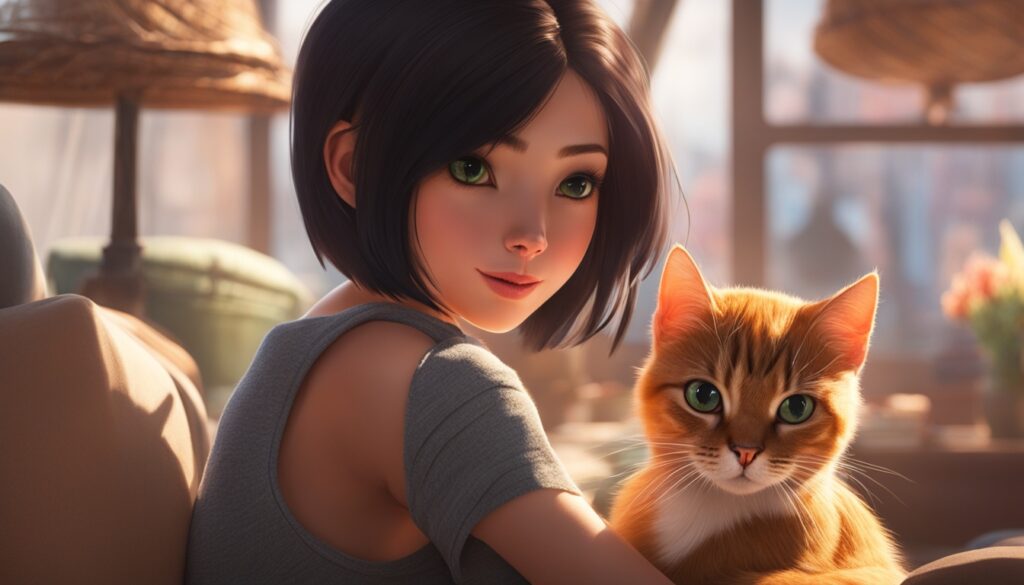
The Pixiebob has a fun pixiebob personality and sweet pixiebob behavior. They are smart, social, and love to play. Pixiebobs are not too energetic, but they know how to have fun.
Pixiebobs make unique sounds like “chirps,” “chatters,” and “growls.” They don’t meow much. They love people and animals, and they like being around them.
They like to head-butt, play fetch, and walk on a leash. Pixiebobs are smart and can learn commands and tricks. With the right training, they become great pets for families and singles.
The Pixiebob‘s pixiebob behavior is a mix of fun, love, and calm. They are a favorite among cat lovers. For more info, check out the Kitty FAQs website.
Health
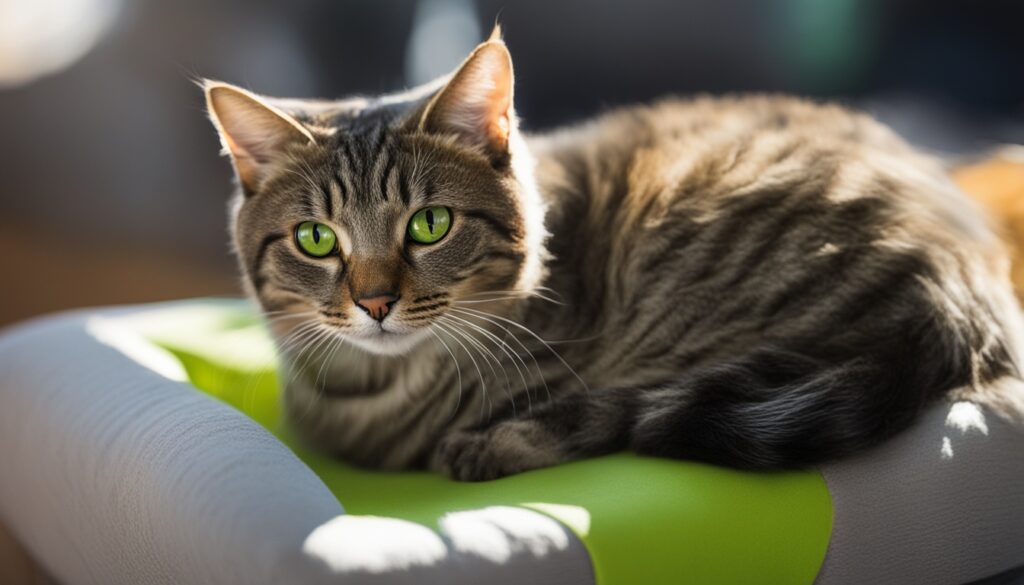
The Pixiebob looks wild but is not as scary as it seems. They are usually healthy because they are mixed with other cats. This mixing helps avoid health problems that come from breeding too closely.
But, Pixiebob cats can have some health issues. They might have problems like undescended testicles, hard labor when giving birth, uterine growth issues, or heart disease. Breeders keep track of these issues in a database called Pawpeds.
It’s important to take Pixiebob cats to the vet often. Working with a good vet helps keep them healthy. Pixiebob cats can live a long, happy life with the right care.
History
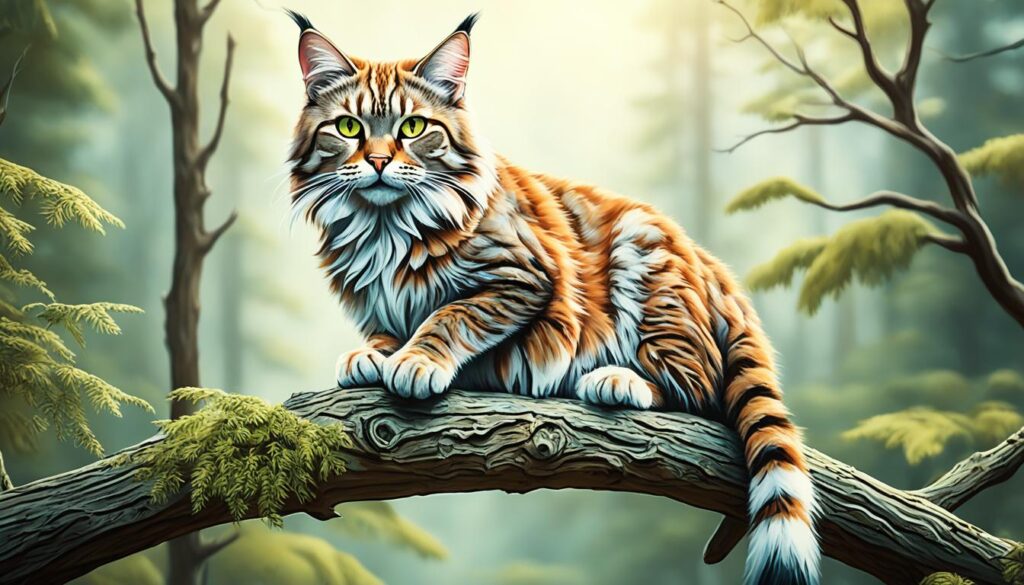
The pixiebob breed has a mysterious history. There’s no proof they come from the North American bobcat, but they look alike. These cats are fully domestic and share looks with their wild cousin.
In the 1980s, Carol Ann Brewer saved a cat with extra toes. This led people to think he might be a mix of a domestic cat and a bobcat. But, we never proved it for sure.
Brewer kept breeding cats with short tails and unique spots. She created the pixiebob breed we love today. No wild bobcats were used in making these cats.
The pixiebob breed got official recognition from the International Cat Association (TICA) in 1994. This made them a special and interesting cat type. Even though we don’t know much about their origins, these cats have won the hearts of many with their unique looks and sweet nature.
Conclusion
The Pixie-bob is a special cat that looks like a bobcat but acts like a house cat. They look wild but are really friendly. Pixie-bobs love people and act like dogs, making them great pets.
They have cool features like tufted ears and strong bodies. Pixie-bobs are smart, social, and love being around people. They make great friends or playmates.
If you want a unique cat, think about getting a Pixie-bob. They are known for being friendly, looking different, and being amazing cats. Adopt a Pixie-bob and see how wonderful they can be.
